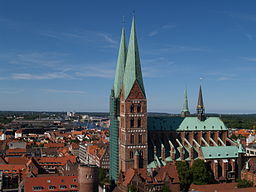Habsburg Dynasty
History of Germany between 1255 - 1516
For almost twenty years after the death of Conrad IV in 1254, the German princes fail to elect any effective king or emperor. This period is usually known (with a grandiloquence to match the Great Schism in the papacy) as the Great Interregnum. It ended with the election of Rudolf I as German king in 1273. The choice subsequently seems of great significance, because he was the first Habsburg on the German throne. During the next century the electors choose kings from several families.
Charles IV was crowned emperor in Rome in 1355. He made his capital in Prague (he has inherited Bohemia as well as Luxembourg), bringing the city its first period of glory. The imperial dignity remained in Charles's family until 1438, when it is transferred again to the Habsburgs. The real ascendancy of the Habsburgs began when Frederick V, the king of Germany from 1440, was crowned Holy Roman emperor as Frederick III in 1452. The Habsburgs married their way to the power. They began with Austria and then married the princesses from Netherlands, Burgundy, the duchy of Milan, Sicily and finally Spain merging countries under their power including all dominions on the American continent. The highpoint of Habsburg power came under Charles V (1500-58) who ruled over an empire over which the sun never set.
In 1356 Charles IV issues the "Golden Bull" which clarified the new identity which the Holy Roman empire had gradually adopted. It ended papal involvement in the election of a German king, by the simple means of denying Rome's right to approve or reject the electors' choice. The Golden Bull also clarified and formalized the process of election of a German king. The choice was traditionally been in the hands of seven electors, but their identity has varied. In return, by a separate agreement with the pope, Charles abandoned imperial claims in Italy - apart from a title to the kingdom of Lombardy, inherited from Charlemagne.
Imperial Cities
The fragmented political structure of Germany had certain advantages for the larger German towns. An elected emperor often found it difficult to control virtually independent territories, held by hereditary nobles or by dignitaries of the church. In such circumstances there may had a natural alliance between the emperor and the citizens of a prosperous borough - who frequently had their own grudge against their local feudal overlord. The rich burghers were able to help the emperor with funds or troops for his armies and he was able help burghers with privileges to protect their trade. Gradually, over the centuries, a premier league of German cities began to emerge. Such cities ran their own affairs and make alliances among themselves for mutual benefit, even put armies into the field to enforce their interests. Each of them was ran by a Rat, or council, membership of which is often limited to the leading local families. Imperial cities were inclined to group together in large trading alliances - of which the Hanseatic League is the best known example. A document of 1422 lists 75 free German cities. They included many of the most distinguished places in early German history - Aachen, Cologne, Lübeck, Hamburg, Bremen, Dortmund, Frankfurt am Main, Regensburg, Augsburg, Nuremberg, Ulm. From 1489 all the free cities were formally represented in the imperial diet.
The Hanseatic League was a commercial and defensive confederation of merchant guilds and their market towns (like Lübeck, Rostock and Wismar). It dominated Baltic maritime trade (c. 1400-1800) along the coast of Northern Europe. It stretched from the Baltic to the North Sea and inland during the Late Middle Ages and early modern period.
Population and Economy
Around 1350 Germany and almost the whole of Europe were ravaged by the Black Death. Jews were persecuted on religious and economic grounds; many fled to Poland. The Black Death is estimated to have killed 30–60 percent of Europe's population in the 14th century. After the plague and other disasters of the 14th century, the early-modern European society gradually came into being as a result of economic, religious, and political changes. A money economy arose which provoked social discontent among knights and peasants. Gradually, a proto-capitalistic system evolved out of feudalism. The Fugger family gained prominence through commercial and financial activities and became financiers to both ecclesiastical and secular rulers. The knightly classes found their monopoly on arms and military skill undermined by the introduction of mercenary armies and foot soldiers. Predatory activity by "robber knights" became common.
During his reign from 1493 to 1519, Maximilian I tried to reform the Empire. An Imperial supreme court was established, imperial taxes were levied, and the power of the Imperial Diet was increased. The reforms, however, were frustrated by the continued territorial fragmentation of the Empire.
References: Wikipedia, Historyworld.net, Hyperhistory.com
Previous historical period: Hohenstaufen Dynasty (1125-1254) | Next historical period: Reformation & Wars of Religion (1517-1617)Popular sites founded between 1255 and 1516 in Germany
Old Town Hall
Munich, Germany
1392
The Church of Our Lady
Munich, Germany
1468-1488
Bremen Town Hall and Roland Statue
Bremen, Germany
1404-1410
Bremen Ratskeller
Bremen, Germany
1405
Munich Residenz
Munich, Germany
1508
Aachen City Hall
Aachen, Germany
1330
St. James' Church
Rothenburg ob der Tauber, Germany
1311-1484
Church of Our Lady
Nuremberg, Germany
1352-1362
Bamberg Town Hall
Bamberg, Germany
1386
Ulm Minster
Ulm, Germany
1377
St. Lorenz Church
Nuremberg, Germany
1400
Albrecht Dürer's House
Nuremberg, Germany
1420
Franciscan Friary
Rothenburg ob der Tauber, Germany
1281
St. Gangolf's Church
Trier, Germany
1284-1344
Regensburg Cathedral
Regensburg, Germany
1273
St. Thomas Church
Leipzig, Germany
1496
Isartor
Munich, Germany
1337
Hospital of the Holy Spirit
Nuremberg, Germany
1332-1339
St. Mary's Church
Rostock, Germany
1265
St. George's Collegiate Church
Tübingen, Germany
1470
Old City Hall
Esslingen am Neckar, Germany
1422
St. James' Church
Hamburg, Germany
1255
Old Main Bridge
Würzburg, Germany
1473-1543
St. Lambert's Church
Münster, Germany
1375-1450
